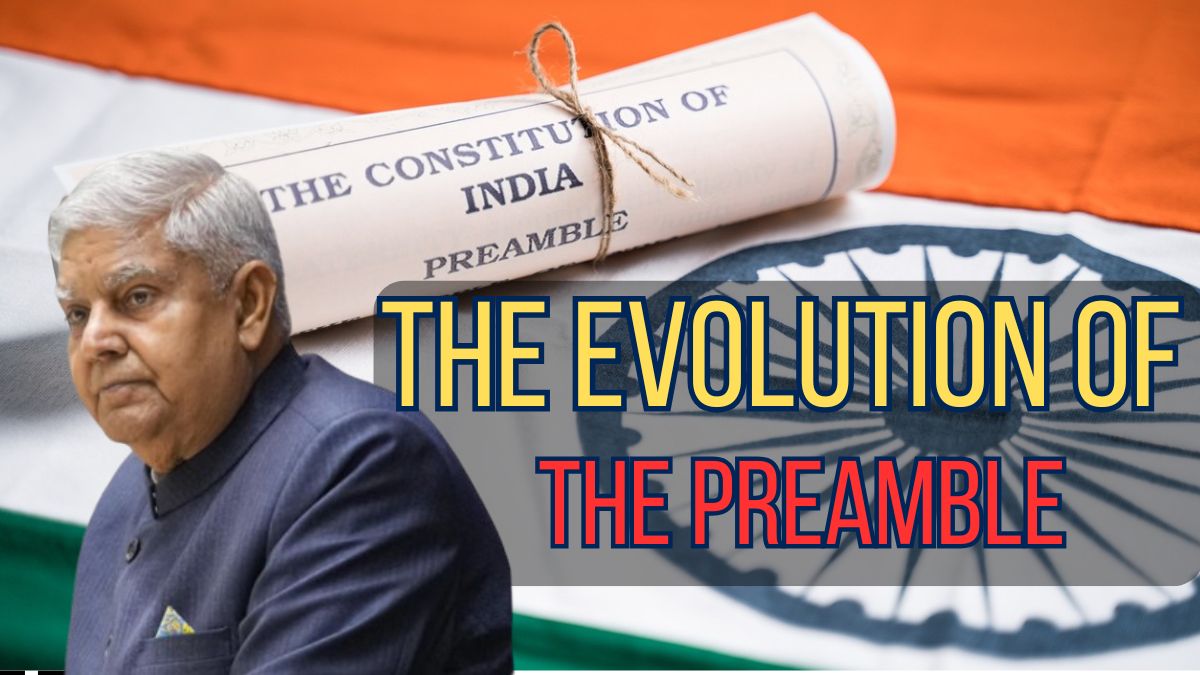The Constitution of India stands as a beacon of democratic values and governance. Its Preamble, typically referred to as the “crucial to the Constitution,” encapsulates the ideals and visions of the framers. It is also at the heart of political and historical arguments, especially relating to modifications introduced throughout the Emergency duration of 1975-77. This blog checks out the origins, changes, and continuous discussions surrounding the Indian Constitution’s Preamble.

What Makes the Preamble Unique in Indian Democracy?
Every Constitution has a starting point, a declaration of intent, and a reflection of the country’s ethos. For India, the Preamble is that entrance. Drafted diligently under the leadership of Dr. B.R. Ambedkar and the Indian Constituent Assembly, the original text aimed to encapsulate the principles of liberty, justice, equality, and fraternity.
Vice President Jagdeep Dhankhar just recently mentioned that the Preamble is the “seed” from which the Constitution grows and considered it “not changeable.” Providing the Preamble a raised symbolic status, Dhankhar highlighted that no other Constitution worldwide has had its Preamble changed, making India’s an exception.
Is the “unchangeable” Preamble really as static as it may appear? To answer this, we need to review the political turbulence of 1976.
The 42nd Amendment and the Changes Made
The infamous 42nd Constitution Amendment Act of 1976, passed throughout Prime Minister Indira Gandhi’s Emergency guideline, left an indelible mark on the Indian democratic structure. Amid increased centralization and political suppression, 3 keywords were contributed to the Preamble, replacing years of established norms:
” Socialist”.
” Secular”.
” Integrity”.
These additions were meant to align the text with the government’s ideological story of the time. By introducing words like “socialist” and “nonreligious,” the modification even more asserted India’s dedication to egalitarianism and spiritual neutrality, while “stability” stressed national unity in the middle of increasing internal disputes. Nevertheless, these changes were considered controversial by critics who believed they deviated from the vision of the Constitution’s framers.
Union Minister Jitendra Singh recently echoed similar sentiments, defending the Rashtriya Swayamsevak Sangh (RSS) require revisiting the insertion of these terms. According to him, these additions, while legally enacted, were more a reflection of political opportunism rather than constitutional need.
Why Some Advocate for a “Review”
One of the ongoing arguments surrounding the 42nd Amendment is whether it distorts the “original spirit” of the Preamble and by extension, the Constitution. The RSS and its advocates argue that foundational principles like “liberty, equality, and justice” were suggested to be generally inclusive and sufficient in communicating democratic suitables.
Adding “socialist” to an already welfare-oriented governance design or “secular” to a nation that naturally values religious pluralism, in their view, develops redundancy. Critics assert that these terms have actually been exploited in political discourse, often to polarize voters or push specific agendas.
On the other hand, others see these modifications as natural evolutions that attend to the socio-political realities of contemporary India. They argue that fairness, unity, and inclusivity should not just stay core perfects however also be legally specific for future generations.
What Critics Say About Revisiting the Preamble
The Congress celebration highly rebuked require evaluating the Preamble’s terms, labeling such efforts as “political opportunism.” Numerous opposition parties slam these arguments as attempts to water down the secular fabric of the country. Even as proponents like RSS-linked magazines clarify that they do not intend to “take apart” the Constitution however just to restore its “original intent,” concerns stay about the requirement and timing of such discourse.
The Preamble’s status as a guidepost for translating the Constitution means any change would likely set off broader constitutional, legal, and political disputes. Is a review worth reigniting such intricacies?
What Does This Debate Tell United States About India’s Democracy?
The advancement of the Preamble shows India’s vibrant sociopolitical landscape. Amendments and legal interventions highlight a nation’s adaptability, however they also highlight the difficulties of consensus-driven governance in a varied nation like India.
Ultimately, the question of whether or not to review the Preamble surpasses partisan politics. It is a workout in self-questioning. Do we stay doggedly committed to the ‘ initial phrasings, or do we enable room for development through amendments to line up with contemporary difficulties?
What is clear, however, is that any decision surrounding the Preamble will demand a regard for the perfects of democracy, recognized institutions, and the will of the individuals.
Looking Ahead
The Preamble and its changes remain a topic of intense argument, and rightfully so. As the seed from which the Indian democracy blossoms, it acts as both an ethical compass and a historical file. Moving on, all discussions about the Constitution or the Preamble must ensure they do not jeopardize the shared worths that join India.
India stands at the crossroads of custom and modernity. Whether the Preamble undergoes another evaluation or stays as is, the nation’s dedication to democracy, inclusivity, and secularism should remain unfaltering.
Frequently asked questions About the Indian Constitution and Preamble
1. What is the significance of the Preamble in the Indian Constitution?
The Preamble acts as the introduction to the Constitution, describing the core principles of justice, fraternity, equality, and liberty. It reflects the directing viewpoint and goals of the country.
2. Is the Preamble lawfully enforceable in a law court?
No, the Preamble is not legally enforceable. However, it serves as a guiding structure for translating the Constitution and understanding its fundamental perfects.
3. Has the Preamble to the Indian Constitution been modified?
Yes, the Preamble was changed in 1976 throughout the Emergency through the 42nd Amendment, which added the words “socialist,” “secular,” and “stability.”.
4. Why does the Preamble describe India as a “sovereign, socialist, nonreligious, democratic republic”?
These terms encapsulate India’s core identity and goals, highlighting independence, inclusivity, and a commitment to social justice and democracy.
5. Can the Preamble be used to challenge policies or laws?
While it can not be utilized independently to challenge laws, the Preamble assists courts analyze the Constitution and evaluate whether laws align with its basic concepts.
Its Preamble, typically referred to as the “essential to the Constitution,” encapsulates the suitables and visions of the framers. For India, the Preamble is that entryway. Eventually, the question of whether or not to review the Preamble goes beyond partisan politics. The Preamble and its changes remain a topic of extreme argument, and rightfully so. Moving forward, all discussions about the Constitution or the Preamble must ensure they do not jeopardize the shared values that join India.
For More Information Click Here



